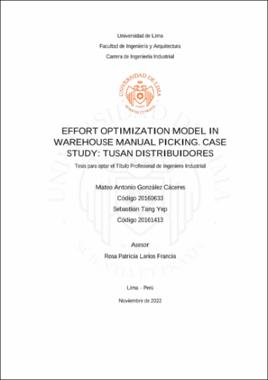| dc.contributor.advisor | Larios Francia, Rosa Patricia | |
| dc.contributor.author | González Cáceres, Mateo Antonio | |
| dc.contributor.author | Tang Yep, Sebastian | |
| dc.date.accessioned | 2023-01-25T14:52:20Z | |
| dc.date.available | 2023-01-25T14:52:20Z | |
| dc.date.issued | 2022 | |
| dc.identifier.citation | González Cáceres, M. A. & Tang Yep, S. (2022). Effort Optimization Model in Warehouse Manual Picking. Case Study: Tusan Distribuidores [Tesis para optar el Título Profesional de Ingeniero Industrial, Universidad de Lima]. Repositorio institucional de la Universidad de Lima. https://hdl.handle.net/20.500.12724/17465 | es_PE |
| dc.identifier.uri | https://hdl.handle.net/20.500.12724/17465 | |
| dc.description.abstract | A recurring and expensive operation in company’s warehouses is the picking. Operators who execute this activity perform repetitive physical movements and carry objects constantly, which can trigger
musculoskeletal disorders. Adittionally, there is a great consumption of energy by the operators, which
could have negative consequences in the long term. Health damages could reduce the quality of the
company’s service and productivity due to the increase in absenteeism of the personnel because of the
recovery. The objective of the investigation is the application of an optimization model to reduce energy
consumption during picking through the redistribution of product lines within a warehouse. The warehouse
under study belongs to a Peruvian distributor with several lines of products for mass consumption. The applied model will be the one proposed by Diefenbach & Glock. The data of the current situation taken
were: demand, average weights per line, efforts, distances and locations, which were coded in “A
Mathematical Programming Language” (AMPL) and solved using the CPLEX solver. The results show
4.4% reduction in energy expenditure compared to the current distribution and 6.0% compared to randomly
generated distributions. Finally, the optimal distribution by product lines is presented as a result of the
modelling that reduces effort. | en_EN |
| dc.format | application/pdf | |
| dc.language.iso | eng | |
| dc.publisher | Universidad de Lima | |
| dc.rights | info:eu-repo/semantics/openAccess | * |
| dc.rights.uri | https://creativecommons.org/licenses/by-nc-sa/4.0/ | * |
| dc.source | Repositorio Institucional - Ulima | |
| dc.source | Universidad de Lima | |
| dc.subject | Almacenes | es_PE |
| dc.subject | Trabajadores | es_PE |
| dc.subject | Sistemas de preparación de pedidos | es_PE |
| dc.subject | Distribución comercial | es_PE |
| dc.subject | Sistema musculoesquelético | es_PE |
| dc.subject | Ergonomía | |
| dc.subject | Estudios de prefactibilidad | es_PE |
| dc.subject | Warehouses | en_EN |
| dc.subject | Employees | en_EN |
| dc.subject | Order picking systems | en_EN |
| dc.subject | Physical distribution of goods | en_EN |
| dc.subject | Musculoskeletal system | en_EN |
| dc.subject | Human engineering | en_EN |
| dc.subject | Prefeasibility studies | en_EN |
| dc.title | Effort Optimization Model in Warehouse Manual Picking. Case Study: Tusan Distribuidores | en_EN |
| dc.type | info:eu-repo/semantics/bachelorThesis | |
| thesis.degree.level | Título Profesional | |
| thesis.degree.discipline | Ingeniería Industrial | es_PE |
| thesis.degree.grantor | Universidad de Lima. Facultad de Ingeniería y Arquitectura | |
| dc.publisher.country | PE | |
| dc.type.other | Tesis | |
| thesis.degree.name | Ingeniero Industrial | |
| renati.advisor.orcid | https://orcid.org/0000-0002-1471-9185 | |
| renati.discipline | 722026 | |
| dc.identifier.isni | 121541816 | |
| renati.author.dni | 76535279 | |
| renati.author.dni | 72815476 | |
| renati.level | https://purl.org/pe-repo/renati/level#tituloProfesional | * |
| renati.advisor.dni | 9304466 | |
| renati.juror | Quiroz Flores, Juan Carlos | |
| renati.juror | Larios Francia, Rosa Patricia | |
| renati.juror | Collao Diaz, Martin Fidel | |
| renati.type | https://purl.org/pe-repo/renati/type#tesis | * |
| dc.subject.ocde | https://purl.org/pe-repo/ocde/ford#2.11.04 | |
| ulima.cat | OI | |





